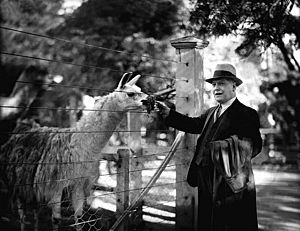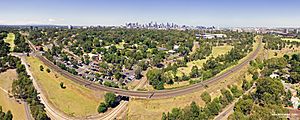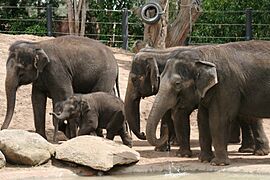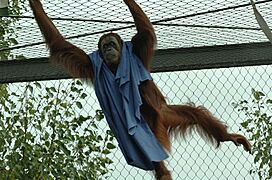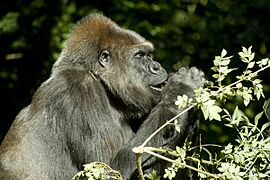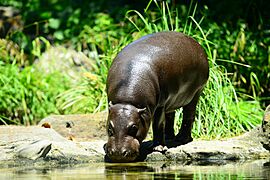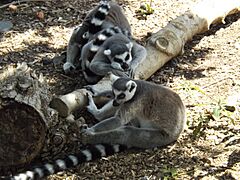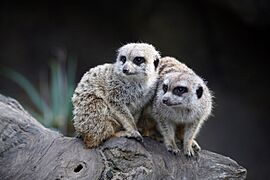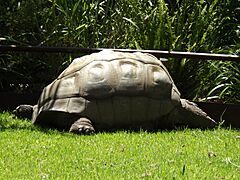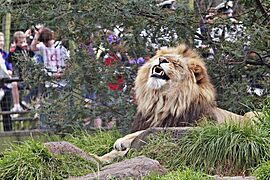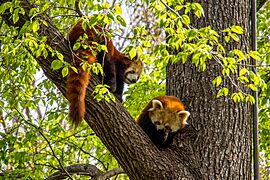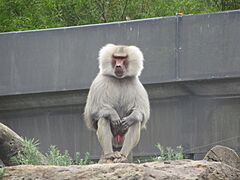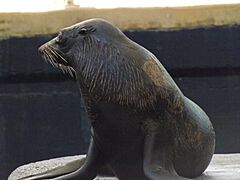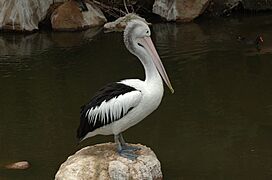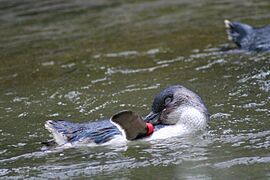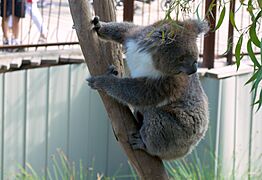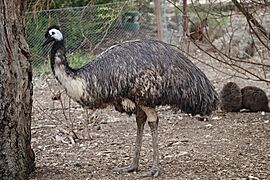Melbourne Zoo facts for kids
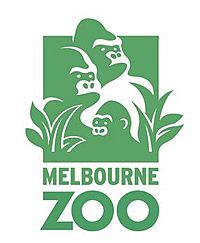 |
|

The main entrance to Melbourne Zoo, 1940
|
|
| Date opened | 6 October 1862 |
|---|---|
| Location | Parkville, Melbourne, Victoria, Australia |
| Land area | 55 acres (22 ha) |
| Coordinates | 37°47′05″S 144°57′08″E / 37.784762°S 144.952095°E |
| No. of animals | 5,120 |
| No. of species | 250 |
| Memberships | Zoo and Aquarium Association, World Association of Zoos and Aquariums |
| Major exhibits | Elephants, lions, tigers, orang-utans, gorillas |
Melbourne Zoo is a zoo in Melbourne, Australia. It is located within Royal Park in Parkville, approximately 4 kilometres (2.5 mi) north of the centre of Melbourne. It is the primary zoo serving Melbourne. As of 2021, the zoo contains 3742 animals comprising 243 species, from Australia and around the world. The zoo is accessible via Royal Park station on the Upfield railway line, and is also accessible via tram routes 58 and 19, as well as by bicycle on the Capital City Trail. Bicycles are not allowed inside the zoo itself.
The Royal Melbourne Zoological Gardens is a full institutional member of the Zoo and Aquarium Association and the World Association of Zoos and Aquariums.
The zoo is set among flower gardens and picnic areas. Many of the animals are now organised in bioclimatic zones: African rainforest ('Gorilla Rainforest') that include gorillas and lemurs; Asian rainforest ('Trail of the Elephants') that includes elephants, orangutans, tigers and otters; and the Australian bush with kangaroos, koalas, wombats, goannas, native birds and many others. Popular exhibits also include the 'Butterfly House', the 'Reptile House', the 'Great Flight Aviary', 'Wild Sea', 'Treetop Apes and Monkeys' and 'Lion Gorge'. During the summer months they also hold sleep over events at the zoo that allows people to purchase tickets to "camp out" for a night under the stars.
The zoo includes a large schools section and caters to many school visitors annually, its immensely popular education program encourages young minds to conserve animals.
Visitors can see historical cages including the heritage listed Elephant House, which has been renovated and adapted for use for customers paying to sleep overnight in tents at the zoo in popular Roar and Snore evenings. These evenings allow the public to see some of the nocturnal animals at the zoo in evening guided tours by experienced camp hosts.
Contents
History
In October 1857, the Zoological Society of Victoria was formed with the aim of introducing animals and plants from overseas. Its first collections of animals were housed in Richmond Paddock. In 1861 the organisation changed its name to the "Acclimatisation Society of Victoria".
On 6 October 1862, the organisation opened a new Melbourne Zoo in Royal Park on 55-acre (22 ha) of land donated by the City of Melbourne. Melbourne Zoo was modelled on London Zoo.
Initially the zoo was important for the acclimatisation of domestic animals recovering from their long trip to Australia. It was only with the appointment of Albert Alexander Cochrane Le Souef in 1870 that more exotic animals were procured for public display, and the gardens and picnic areas were developed. 1870 also saw the Society change its name to the "Zoological and Acclimatisation Society of Victoria", and was granted the prefix "Royal" in 1910.
One of the most famous exhibits from the early 1900s to the 1940s was Queenie the elephant.
In the mid-1930s, the Society had financial troubles. In response the Zoological Gardens Act 1936 was passed, handing the Zoo to a newly appointed Zoological Board of Victoria on behalf of the state government in 1937.
In 1964, the acclaimed Lion Park exhibit opened, with an elevated walkway overlooking and separating two exhibits. It was demolished and replaced by a new lion exhibit in 2014.
Australia's first gorilla birth occurred at Melbourne Zoo in 1984. Giant pandas were loaned to the zoo from China for an exhibition to celebrate Australia's bicentennial in 1988.
In 1989, a 35-year-old man died when he was partially eaten by a lion after he entered its pen.
The Trail of the Elephants exhibit was unveiled in 2003 and won numerous awards. On 15 January 2010 Melbourne Zoo welcomed its first elephant calf, Mali. This is the second elephant calf born in Australia, the first being in Sydney in July 2009. Mali is the first female calf born in Australia and the first calf born via artificial insemination.
Melbourne Zoo commemorated 150 years of operation in 2012 and this was celebrated in an Australian Zoos collector's edition of stamps released by Australia Post in September 2012.
The Zoo completed construction and opened a new carnivores trail in early 2018.
Zoos Victoria
Zoos Victoria administers the Melbourne Zoo, as well as the Werribee Open Range Zoo, which features herbivorous creatures in an open-range setting; and Healesville Sanctuary (formerly the Sir Colin MacKenzie Sanctuary), which exhibits Australian fauna on 175 hectares (430 acres) of bushland.
The three zoos have been collectively trading as Zoos Victoria since 1973, governed by the Zoological Parks and Gardens Board, which operates under the Zoological Parks and Gardens Act 1995.
In July 2022, Kyabram Fauna Park joined Zoos Victoria.
Colossal Biosciences and Zoos Victoria began a conservation project in October 2023 to preserve the Victorian Grassland Earless Dragon as well as sequence its genome.
Exhibits
- Gorilla Rainforest
- Growing Wild
- Trail of the Elephants
- Asian elephant
- Asian small-clawed otter
- Bolivian squirrel monkey
- Eclectus parrot
- Noisy pitta
- Siamang
- Sumatran orangutan
- Wild Sea
- Australian fur seal
- Little penguin
- Long-nosed fur seal
- Australian Bush
- Budgerigar
- Emu
- Gouldian finch
- Koala
- Lace monitor
- Long-nosed potoroo
- Orange-bellied parrot
- Quokka
- Rainbow lorikeet
- Southern hairy-nosed wombat
- Tasmanian devil
- Tawny frogmouth
- Western grey kangaroo
- White-browed woodswallow
- Great Flight Aviary
- Black-faced cormorant
- Black-necked stork
- Black swan
- Blue-faced honeyeater
- Buff-banded rail
- Bush stone curlew
- Cattle egret
- Eclectus parrot
- Freckled duck
- Glossy ibis
- Leadbeater's cockatoo
- Pacific emerald dove
- Pied heron
- Radjah shelduck
- Red-collared lorikeet
- Red-tailed black cockatoo
- Satin bowerbird
- Southern cassowary
- White-faced heron
- Wonga pigeon
- Lion Gorge
- DigestED
- World of Frogs
- Reptile House
- Coastal taipan
- Corn snake
- Double crested basilisk
- Dumeril's boa
- Eastern box turtle
- Eastern diamondback rattlesnake
- Elongated tortoise
- Eyelash viper
- Fiji crested iguana
- Freshwater crocodile
- Frilled lizard
- Golden coin turtle
- Honduran milk snake
- King cobra
- Lined earless dragon
- Madagascar giant day gecko
- Mexican cantil
- Monocled cobra
- Philippine crocodile
- Philippine sailfin lizard
- Pueblan milk snake
- Pygmy mulga monitor
- Rainbow boa
- Red-barred dragon
- Rhinoceros iguana
- Russian tortoise
- Shingleback lizard
- Spiny terrapin
- Tiger snake
- Twist-necked turtle
- Main Trail
Gallery
See also


